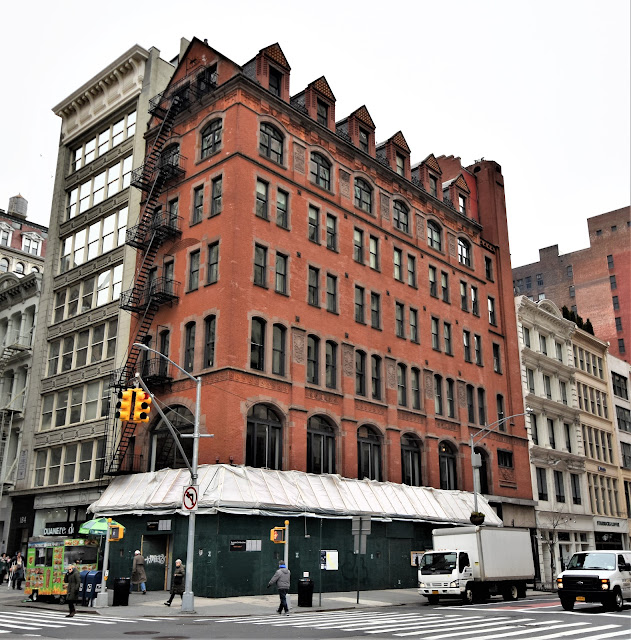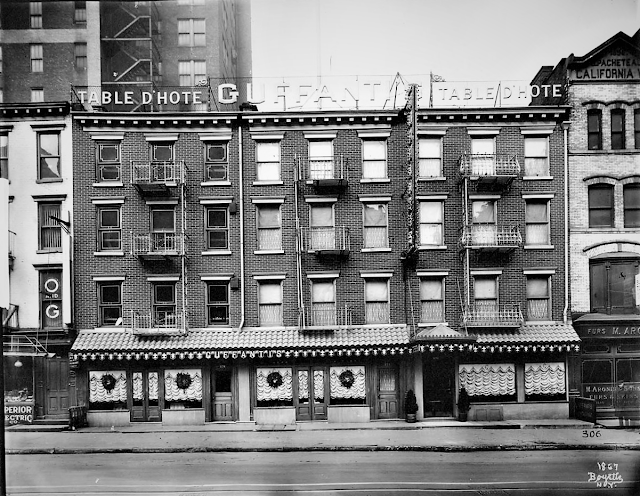 |
| photograph by the author |
Young Clarence had a privileged education, graduating from Worchester Academy in Massachusetts and from Harvard University in 1905. On February 4, 1908 he married Anne McEldin Douglass. The couple would have two children, Clarence Douglass Dillon, born in 1909, and Dorothy Anne Dillon, born in 1912.
The same year that Dorothy was born 1912 Dillon joined the brokerage firm of William A. Read & Company in Chicago; relocating to the company's New York office two years later. After Read died in 1916, Dillon purchased the majority of stock and rose to the head of the firm. In 1921 it was renamed Dillon, Read & Co.
By then Dillon's success and resultant personal fortune was reflected in his club memberships. In 1920 he was a member of the Metropolitan, Riding, Sleepy Hollow Country, Harvard and Esssex Hunt Clubs of New York; and the Metropolitan and Riding Clubs of Washington D. C. The family was living fashionably at No. 635 Park Avenue.
In 1925 Dillon diversified, purchasing the automobile maker Dodge Brothers Company for $146 million. Two years later he merged the company with Chrysler Corporation. It was time for the Dillon family to have a residence on par with their financial and social status.
Dillon purchased the three old houses at Nos. 122 through 126 East 80th Street, between Park and Lexington Avenues in 1928. The block had already attracted the attention of wealthy homeowners. Vincent Astor had constructed his Regency-style stone mansion at No. 130 in 1926.
Now Dillon turned to Astor's architect, Mott B. Schmidt, to design a mansion to replace the houses at Nos. 124 and 126 (he sold the third property to George Whitney who would erect his own handsome townhouse there in 1930). Schmidt famously designed residences in 18th century styles; most notably, perhaps, several neo-Georgian mansions on Sutton Place earlier in the decade.
Completed in 1930, the four-story 80th Street house imitated a Georgian townhouse. Faced in brown-gray Flemish bond brick, its aloof 18th century design featured a handsome doorway with fluted pilasters and bold arched pediment. There would be little other stonework on the facade. Mott created the quoins along the sides and the imitation blocks of the Gibbs-type surround of the second floor opening in brick. Only two bandcourses, a single keystone and the third floor cornice were stone.
Dillon simultaneously commissioned Schmidt to design the 20,000-square-foot neo-Georgian mansion on his 118-acre summer estate, Dunwalke, in New Jersey.
The new city house required additional servants. The Dillons had made do with five on Park Avenue; but when they moved into the 30-room 80th Street house the staff grew to 14--plus two security personnel. Clarence Dillon was understandably concerned about the safety of his family. The 1920's saw radical Marxists and anarchists targeting capitalists with violence--as vividly exemplified by the September 1920 terrorist attack on the J. P. Morgan & Co. building on Wall Street. In response, Dillon augmented the household staff with a night watchman and a private motorcycle cop who made rounds throughout the night.
Young Clarence was attending Harvard University when the house was completed. On January 14, 1930 the school's wooden locker house burned to the ground. Clarence telephoned home and urged his father to replace the building. The resultant brick field house cost half a million dollars during the Depression years.
Clarence Douglass Dillon did not wait for graduation to marry. On March 11, 1931 The New York Times reported that he and Phyllis Ellsworth had been wed in Boston. The promising young man would go on to an impressive career--serving in the Eisenhower, Kennedy and Johnson administrations as Ambassador to France, Under Secretary of State, and Secretary of the Treasury. During the Cuban Missile Crisis he sat on the Executive Committee of the National Security Council.
In the meantime his father did not slow down. He was a director in five banks and several corporations including the National Cash Register Company. With the outbreak of World War II he served in Washington on the War Industries Board and in 1941.
Anne McEldin Douglass died in 1961. Clarence survived until April 14, 1979 when he died at the age of 96 at Dunwalke.
The Republic of Iraq had purchased No. 124 East 80th Street two years earlier. It was the beginning of a bizarre chapter in the history of the elegant mansion. Although home to the country's ambassador to the United Nations, there were no diplomatic receptions, no glamorous entertainments.
Any maintenance of the building stopped in 1991 when the United States slapped sanctions on Iraq. Famed interior decorator Mario Buatta, a neighbor, later grumbled to writer Laura Shaine Cunningham "There was no décor at all. Sad, very sad. The Iraqis did not do a thing inside. It's in bad shape--has been since they got in in '77. The house could have been beautiful; it was beautiful before they bought it."
There was one decorative item visible through the windows--a life-sized portrait of Saddam Hussein. Wires dangled from each of the windows, prompting one reporter to question whether the Iraqis were "stealing cable." The rear garden--unlike the manicured back yards of its neighbors--was used to store small propane tanks. Neighbors watched as men silently moved from limousines to the door, never responding to greetings.
Ambassador Mohammed al-Douri was a vocal supporter of his boss and detractor of the United States, saying at one point America wanted to "kill everyone in Iraq. He refused to answer questions from specific reporters, calling them "Israelian Jews." In silent protect several homeowners on the block hung American flags in their windows.
Al-Douri walked out of the United Nations in March 2008 accusing the United States of "criminal aggression" and intentions of "a real war of extermination" against Iraq. That would be his last chance to grandstand.
On April 2, 2003 al-Douri no doubt sat in No. 124 watching televised coverage of the fall of Baghdad and the toppling of the statues of Saddam Hussein (who was suddenly no where to be found). Suddenly the former ambassador had no country, no position and was about no have no home.
The following week the Iraqis were ousted from New York, although al-Douri did not go peacefully. Crying "I love New York" on April 9, he refused to accept his subpoena, while at the same time lamenting "the game is over." The following day the 80th Street block was packed with reporters and cameramen waiting for the last appearance of the fallen diplomat.
Al-Douri would suffer one last humiliation. When the door of No. 124 finally opened, he ran through the crowd heading straight to his limo. But his driver had not parked in the accustomed spot and al-Douri was left to look left and right before spotting it up the block. To make things worse, he was unable to get in--the door was locked and his driver was temporarily unable to unlock it.
Years passed and the vacant mansion became even more forlorn as dirt accumulated on the proud facade. Then, in 2014, it appeared that a change was coming. Kim Velsey, writing in The New York Observer on September 19 noted that "to the consternation of neighbors" the house had sat empty since 2003; however Omar Humandi, special assistant to the current ambassador, said "they've started talking to engineers and architects about finally renovating the place."
Any renovations were not what the moneyed neighbors had in mind. In 2017 the Department of Buildings received several complaints that the Republic of Iraq was operating the mansion as "a commercial gym." The operation was ended and the Dillon mansion was again abandoned--a wistful reminder of a grand past.


































